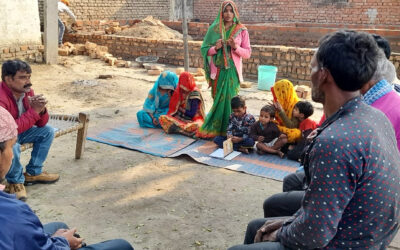In the course of her work, there are times when Free the Slaves South Asia Director Supriya Awasthi feels that her safety is at risk. This was the case when she was with the CNN news crew as they documented the reality of modern-day slavery in India. At one point, slaveholders appeared. Intimidating muscle men put pressure on Supriya and the crew to leave.
But they stayed. And the risk was worth it, because the CNN cameras were able to capture the factors that force, and keep people in slavery, sometimes for generations. Much of Supriya’s work takes place in Uttar Pradesh, India where entire families are put into debt bondage—forced to work off bogus debts, brutally beaten if they try to escape. One family was enslaved over a debt of 100 rupees, the equivalent of 22 dollars. One man is working off the debt of his father: a mere 8,000 rupees, the equivalent of less than 180 dollars. Another woman says she is illiterate, so she has no idea how much she owes.
Around the three minute mark in the video above, Supriya says that of the 27 million slaves in the world today, the majority reside in India. Slavery is outlawed there. But these enslaved laborers often have no idea. Lack of education, lack of access to economic opportunities, lack of empowerment, complacency or corruption of law enforcement and government officials are just some of the forces that trap people in slavery.
But there is hope. This segment is the first of three video pieces CNN produced about slavery in India. Other pieces will show the work being done to eradicate debt bondage—they will show communities organizing and coming together to demand their rights. Stay tuned! We’ll share these pieces with you as they air.
Supriya spent several days with the CNN crew. She was with them when the cameras caught a raid on a loom where children were enslaved. Six children were rescued from debt bondage that day. The cameras were also there to document the success of Free the Slaves’ Free a Village, Build a Movement campaign, in which entire communities are released from generational slavery.
Supriya says she was especially heartened that the camera crew were able to capture a village that has come into freedom The atmosphere was “like a fair!” she said. The CNN crew told her, “we never saw such a happy village.”
We are excited to be part of CNN’s Freedom Project. Launched just yesterday, this year long initiative will depict slavery in all its nuances, all over the world. CNN’s daily coverage of modern-day slavery is already bringing new attention and energy to anti-slavery movement.
We’ll leave you with this parting shot. Supriya has worked with numerous camera crews over the years. She said “the CNN crew was the best production team I have ever worked with. When all said and done. I think CNN got the best story ever on slavery.”
Read the accompanying CNN article by reporter Sara Sidner after the jump:
Generations pay off debts through slavery
Uttar Pradesh, India—An army of workers, their faces encrusted with dust, toils beside a story-high pile of unfired bricks. They are helping build a new India that appears to be leaving them behind.
From sunup to sundown they spend their time pouring wet mud into molds, lugging them to the kiln, firing them and then pulling them out. For their backbreaking work, they do not receive wages.
They are working to pay off a debt.
In India they are known as bonded laborers, bound to those who gave them or their forefathers an advance or a loan. Human rights advocates call them modern day slaves.
“I cannot leave here unless I pay my debt,” said Durgawati, a mother of three.
A contractor had approached Durgawati and her husband, offering them work in a far-off village. He had said there were plenty of opportunities and offered to pay an advance to prove it. Desperate to make a living and with no work in sight where they lived, they leapt at the chance and took the 1000-rupee ($22) advance, she said.
The contractor found them work, but now, the family said they were trapped.
“I have to make a thousand bricks per day,” Durgawati said. “It’s the most difficult thing. We are given big pieces of soil, then we have to break it. Then we make it into a dough. Then we knead the soil.”

